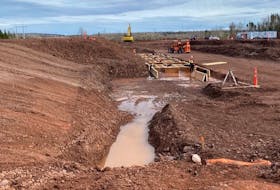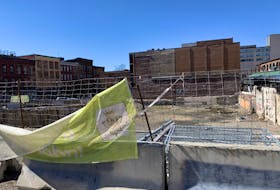Minutes after midnight on June 6, 1944, the first Canadians dropped into France from airplanes, followed hours later by troops storming the beaches and then tanks rumbling in after them. The Allied command had taken advantage of a tiny window of good weather, favourable tides and moonlight, and with three words from the laconic Supreme Commander Dwight D. Eisenhower — “Okay, we’ll go” — they set about reversing their fortunes in the Second World War. More than 10,000 Canadian sailors and 15,000 Canadian troops were involved and, according to the Department of National Defence, they suffered a total of 1,074 casualties on that day alone. And after landing on the beach, they kept battling through France, suffering ever more casualties. Stuart Thomson reveals what Operation Overlord, the battle for the beaches of Normandy, looked like through Canadian eyes on that historic day.
1st Canadian Parachute Battalion
At about 12 minutes after midnight on June 6, the first Canadians to take part in D-Day plummeted through a hole in the belly of a plane and, about 20 seconds later, were on the ground in France leading the Allied invasion.
The 1st Canadian Parachute Battalion’s goal was to cut the bridges near Varaville and Robehomme and protect a British parachute battalion that was attacking German artillery. Due to a variety of problems, including a barrage of anti-aircraft fire that forced the pilots into evasive action, the planes were off-course and way below optimal altitude.
“I thought, ‘Jesus, I’m not going to be anywhere near where the other guys are because it’s taking so long for the others to get out,’ ” said Pte. Jan de Vries, in Juno: Canadians at D-Day, as he jumped into total darkness.
It was just seconds and, bang, I'm on the ground
“You couldn’t see a blessed thing … So I just hung there ready if anything happened. It was just seconds and, bang, I’m on the ground,” he said.
When the Canadians hit the ground, they were scattered and disoriented, but they achieved their objectives.
As the squadron’s bombardier, de Vries was loaded up with a jump bag strapped to his knee, a Sten gun with seven magazines, six 2-inch mortar bombs and smoke grenades packed into every pocket. It amounted to about 70 pounds of additional weight.
The 1st Canadian Parachute Battalion suffered 113 casualties from the 543 soldiers who participated in the drop on D-Day.
Queen’s Own Rifles
As his assault boat approached the beach, Charlie Martin, the Company ‘A’ Sergeant-Major, noticed with trepidation that the bombardment of rockets and naval guns had overshot the beach, leaving very strong enemy positions to greet the 10 boats belonging to the first wave from the Queen’s Own Rifles.
The regiment landed on Nan White Beach just after 8 a.m. and took the worst battering of any Canadians on D-Day. Their objective was to secure the nearby town of Bernières-sur-Mer, which they accomplished in less than an hour.
Left almost to themselves and spread desperately thin across the beach, Martin wrote in his war memoir Battle Diary that he and his men “had never felt so alone in our lives” and felt a “strange silence that gripped us.”
When the boat ramps came down, the infantrymen faced an unbelievable barrage of heavy machine gun fire and mortars. The beach ahead of them was littered with mines and they had no choice but to dart headlong across it to avoid becoming easy targets for the gunners.
“To both sides of us we had minefields. The machine gun fire and mortars never let up, a barrage of shelling that seemed to come from everywhere,” wrote Martin.
In the midst of that chaos, Martin recounts a brief argument, under constant machine gun and mortar fire, with a quarrelsome underling “about who should have the wonderful privilege of cutting these heavy strands of barbed wire.”
A barrage of shelling that seemed to come from everywhere
“This was not the time and place for him to go on and on about how wire cutting was not his speciality, that I was closer, Company Sergeant-Majors were paid more, etc., etc.,” wrote Martin. “So guess who cut the wire?”
Martin cut through the barbed wire and moved into long grass, which gave them cover. As the men crossed the grassy minefield, Martin put his foot on a “jumping mine,” a device that shoots into the air and sprays nails and buckshot over the area. To stop it from jumping, Martin kept his foot on the mine as his men scrambled to safety but, while he stood still, a bullet found the inside of his helmet, knocking it off. Miraculously unharmed, Martin fled to safety “at what you might call top speed.”
By the end of the morning, Martin’s ‘A’ Company had suffered more than 50 per cent casualties. Within the first minutes of landing, the ‘B’ Company received 65 per cent casualties. The Queen’s Own Rifles had the highest casualties of any Canadian regiment, with 143 killed, wounded or captured.
Upon hearing the news about casualties in his company, Martin hid out behind a wall near the regiment’s objective in Bernières-sur-Mer and wept.
D-DAY AT 75: Remembering the heroes and sacrifices of Atlantic Canada:
- VIDEO: The road to D-Day
- Why a school in France is named for a Pictou soldier
- U-boat hunter Roderick Deon returns to Juno Beach for D-Day
- Sound of gunfire rang in P.E.I. soldier’s ears
- North Nova Scotia Highlanders at the sharp end of D-Day invasion
- STORY MAP: Follow the D-Day experience of the North Nova Scotia Highlanders
- 12 North Nova Scotia Highlanders murdered at Abbaye d’Ardenne
- ‘It was noisy as the devil,’ says St. John’s torpedo man
- 59th Newfoundland Heavy Regiment was eager to do its part
- A P.E.I. dispatcher’s long, uncertain journey to Normandy
- LAURENT LE PIERRÈS: D-Day invasion was best birthday present for my Dad
- ‘Sight of our boys being blown up ... wouldn’t leave my mind:’ Bedford veteran, author
- Dartmouth veteran's first combat mission was D-Day invasion
- Halifax air gunner had bird’s-eye view of D-Day
- ‘We had everything fired at us but the galley sink’: Yarmouth County veterans share war and D-Day memories
- New Waterford veteran has lived good life after surviving D-Day invasion
- JOHN DeMONT: An old film clip of D-Day shows the nature of courage
- D-Day landing map’s origins a mystery to army museum historians
North Shore Regiment
The North Shore Regiment sustained its first casualty while the men waited to disembark near Saint-Aubin-sur-Mer, when an armour-piercing bullet screamed through the boat and into the forehead of a young private.
It was a “stunning blow,” for Lt. C.F. Richardson as he waited to command No. 4 platoon onto the beach. The North Shore Regiment was divided up as they stormed the beach and had orders to eventually dovetail together and push inland.
Once out of the boat, the men “acted mechanically, heading for the beach,” with their courage perhaps bolstered by the fact that they had no idea they were crossing a minefield.
“Soon the sniping became the most demoralizing aspect of the day as we began to lose one man after another,” said Richardson, quoted in Paul Williams’ book Hitler’s Atlantic Wall: Normandy: Construction and Destruction.
As the platoons of the North Shore Regiment attacked, the Germans raised white flags only to open fire on the Canadians who broke cover. The next time the white flags went up, the Canadians made sure the German garrisons were “cut to pieces by grenades and rifle fire.” The North Shore Regiment suffered 125 casualties on D-Day.
All around me you could see people on the barbed wire
Royal Winnipeg Rifles
It was a tale of two landings for the Royal Winnipeg Rifles, as one part of the beach saw German emplacements devastated by the Allied naval barrage and another part left almost completely intact.
The ‘B’ company troops who stormed the beach near the Seulles River suffered incredible carnage at the hands of machine guns. Bodies littered the beach, with bullets raked across their knees and chest. The Winnipeg Rifles ‘B’ Company endured some of the highest beach casualties of the day.
Further west, the other companies met only small arms fire after a successful naval barrage.
“We went and tried to pull more guys out of the water,” said Jim Parks, who fought with the Winnipeg Rifles against the intact German defences, and whose account appears in D-Day: Juno Beach: Canada’s 24 Hours of Destiny by Lance Goddard. “All around me you could see people on the barbed wire.”
Parks said mortally wounded soldiers were trained to fall on the wire and squash it down so that “somebody could step on your back and jumped over further.”
The Winnipeg Rifles, who suffered 128 casualties that day, moved inland to the tiny village of Graye-sur-Mer and surged even farther than the military planners expected before digging in for the night.
Parks describes a man named Bull Klos who was mortally wounded, but stormed one of the German pillboxes anyway. “They found him in the pillbox with his hands around a German soldier’s neck. He died that way and so did the soldier,” Parks said.
Royal Regina Rifles
The Royal Regina Rifles landed on the beach near Courseulles-sur-Mer into the most heavily fortified enemy positions that Canadian troops would face that morning. The German guns went quiet as 14 tanks and the Regina Rifles swarmed onto the beach, with hundreds of artillery rounds fired over their heads.
“Fortunately we were in far enough that we didn’t sink. We were in just three or four or five feet of water,” said Jack Read, who made the landing with the Royal Regina Rifles. Read’s account appears in D-Day: Juno Beach: Canada’s 24 Hours of Destiny.
Read was relieved to see that his boat captain “was pretty astute” and weaved around the deadly mines and obstacles in the water. Many of the losses sustained by the Regina Rifles that morning came from landing boats hitting mines near the beach, including massive casualties for its ‘D’ Company, which was left with only 49 infantrymen by the time they cleared the beach.
The regiment moved onto Courseulles-sur-Mer, which they knew was going to a bitter, protracted street-fight. The Regina Rifles had received special urban combat training and, street by street, they cleared the town by mid-afternoon as snipers tried to pick them off in the narrow roads.
The Regina Rifles suffered 108 casualties.
Canadian Scottish Regiment
The Canadian Scottish endured only small pockets of action on the western stretch of Juno Beach and suffered the fewest casualties of any assault battalion that morning.
The regiment’s objective was to get to Putot-en-Bessin and secure a railroad crossing and stop all rail traffic.
Wayne Arnold, of the 1st Battalion of the Canadian Scottish Regiment, wasn’t impressed with the situation.
“Our regiment was in a rear position — you see there were two forward one rear. It wasn’t too exciting. Of course, maybe I’m not the excitable type,” said Arnold, in Goddard’s D-Day: Juno Beach: Canada’s 24 Hours of Destiny.
The Canadian Scottish captured a German emplacement and moved toward Graye-sur-Mer, where they supported the Winnipeg Rifles.
The two regiments started digging into defensive positions, only to be told they had advanced too far and had to move back. By the end of the day, the Canadian Scottish had suffered 87 casualties and taken about 200 prisoners.
Fort Garry Horse Regiment
Many of the tanks belonging to the Fort Garry Horse regiment were late to arrive due to the terribly choppy seas. And although some of the Fort Garry Horse faced little opposition, the tanks supporting the North Shore Regiment found themselves in a shooting gallery. By noon, they cleared the beach after dashing headlong through a minefield and losing three tanks in the process.
“I was scared to death, there’s no doubt about that. Anybody that says that they weren’t scared, they’re lying,” said Frank Ryan, of the North Shore Regiment.
The Fort Garry Horse regiment suffered 25 casualties on D-Day.
Le Régiment de la Chaudière
Pierre Gauthier came ashore with Le Régiment de la Chaudière, a burly crew of farm boys, lumberjacks and coal miners from Quebec.
They landed near Bernières-sur-Mer just after 8:30 a.m. and, after hightailing it across 50 feet of beach, Gauthier’s platoon was reduced to about half a dozen men. As they huddled at the seawall, an officer shooed them towards a pathway to the west.
“We’ll climb up this path and see what happens,” said the commanding officer, a man he only knew as Sergeant Dion, and whose story appears in Juno: Canadians at D-Day by Ted Barris.
What happened was an astounding volley of machine gun fire, which the Chauds edged closer and closer to until they could toss some grenades into the enemy position. After a few minutes, the machine guns were silenced.
By day’s end, they had accomplished their objective and, before long, Gauthier’s platoon was promoted to an infiltration group, doing tricky missions at nighttime. They had already suffered 104 casualties.
At 19 years old, Gauthier was learning a lot about himself, most notably that when things got hairy, when other men were shouting or crying or running at top speed due to throbbing adrenalin, he would catch himself involuntarily laughing out loud. Some of the other men thought he was crazy.
They had already suffered 104 casualties
He was also learning about the other men. Sgt. Dion, for instance, became a different man altogether when he hit the beach, with the mortars and shrapnel and body parts falling around him.
“Sergeant Dion was afraid, the same as we were, but he had a bit more of something that we didn’t have then. It must have been courage,” Gauthier said.
First Hussars
Supporting the 7th Infantry Brigade, the First Hussars tank regiment came ashore between Courseulles-sur-Mer and Bernières-sur-Mer and proceeded to wipe out the German machine gun emplacements, then surged inland.
“In the beginning, it wasn’t patriotism that drove us,” said Bruce Evans, the Hussars’ wireless operator. They were focused on survival and protecting the infantrymen.
“We know our job was to stay in close proximity with the infantry … get them ashore and stay with them as they cleared the town,” he said.
As the wireless operator, Evans was the link between the Hussars and the Royal Winnipeg Riflemen they were supporting.
Evans’ ‘C’ Squadron were mostly doing dry landings, without swimming the tanks ashore, and would be landing nearly an hour after the first troops and tanks hit the beach. The ‘C’ Squadron watched in despair as their sister squadrons flailed in the rough seas and some of them sank like stones. In total ‘A’ Squadron landed seven tanks and ‘B’ Squadron landed 15.
As the ‘C’ Squadron came ashore, traffic started to back up on the beach and Evans jumped out of his jeep to look for an exit, as mortar shells exploded around him. One knocked him down to the ground and Evans had a momentary panic that he’d lost one of his legs.
“Soon, I was coming around and I realized both my legs were mobile. Glory be, I’m alive,” he said.
Despite his protests, Evans was eventually sent to a regimental first-aid post, miles from combat, but soon rejoined his squadron as a tank commander. Meanwhile, the First Hussars suffered 43 casualties on D-Day.
Stormont, Dundas and Glengarry Highlanders
After the initial landing, a second wave of troops landed at 11 a.m. to relieve the first wave and prepare for a German counterattack.
Although they missed the initial barrage from the German defences, the Stormont, Dundas and Glengarry Highlanders were greeted by the gory sight of the blood-soaked beaches.
“I saw another landing craft with a man’s torso wrapped around the propeller. There were other body parts on the beach … I vomited and cried and tried to figure out what was going on,” said Charles Cline, who was 17 years old when he landed on the beach with the Glens.
“They hadn’t been able to clear all the guys off that part of the beach. When I saw half a dozen bodies it struck me that things are going to happen here,” said John McDonald, a corporal for the Glens, who landed with his two brothers.
With the idea that they would storm the beach and then surge inland, the Glens — who suffered 14 casualties that day — were trained on bikes. The soldiers had an ordinary bike and a collapsible one, but it made them easy targets for German snipers when they got onto the French roads.
“Pushing and carrying those damn bikes, we knew we were never going to use them. They were just slowing us down. So we dumped them in an orchard,” said McDonald.
13th and 14 Field Regiment (Artillery)
Before the troops arrived on the beach, the German defences were softened up with a massive saturation barrage of artillery. The artillery regiments, 96 guns on 24 landing craft tanks, fired simultaneously as they moved toward the beach.
“In those last tense moments, as we loaded and fired and loaded and fired like automatons, the shore of France was fully visible, rent and torn with violent explosions and with a dense pall of smoke. … And then the beach itself became visible with a few figures scattered across it, some running, some standing and some lying motionless on the sand,” Sgt. Wes Alkenbrack of the 14 Field Regiment wrote in his diary.
Just after 7 a.m., from about 9,000 yards distance, the 105-mm artillery weapons opened up on the German emplacements on the beach.
“There was no difficulty in carrying out this operation,” wrote Alkenbrack. “With our guns fixed facing forward as they were on the craft … we were aimed directly toward the shore. As the beach got closer, the crews adjusted the guns, raining round after round down on the German defences.”
Alkenbrack also noted in his diary that breakfast that morning was a self-heating can of cocoa and oxtail soup.
The 13th Field Regiment lost an entire landing party after the craft hit a mine, two officers were killed by shells and an officer drowned when his craft overturned. The 13th and 14th would suffer a total of 34 casualties the first day.
Ted Barris, author of Juno: Canadians at D-Day, believes the first decoration won by a Canadian on D-Day belonged to the 13th Field Regiment. Gunner Jack Holtzman saw his entire forward observation group suffer casualties, but he managed to carry on and radio in the location of a German strongpoint. The 13th Field Regiment made short work of them.
Fusiliers de Sherbrooke (27th Armoured Regiment)
After a year-and-a-half of training in England, the Fusiliers de Sherbrooke finally got word that they would be part of D-Day, landing their tanks around noon as part of the second wave.
“I think it had something to do with politics too. We were a Quebec unit,” said Cpl. Gordon Drodge, in Juno: Canadians at D-Day.
Although they missed the initial firefight, the landing was no sure-thing, with mines and rough seas to contend with. The Fusiliers suffered a total of three casualties that day.
“We had a very rough crossing; there was over a foot of water on the deck. When the ramp went down on the landing craft, the tank had to move forward slowly and balance on the ramp, move ahead and then fall forward 11 feet into the water,” said “Bomber” Bateman, one of the battle captains for the Fusiliers, in the book Fifty Years After by John Gardam.
With traffic backed up on the beach and on the roads into the nearby towns, Drodge had time to mingle with French citizens who came out to greet the Allies.
The Fusiliers offered bread and rations and the civilians returned the favour with lots of Calvados, a local liqueur, which the Canadians had to mix with juice to stomach. Drodge would later remember seeing townsfolk shaving the heads of women they suspected of collaborating with the Nazis.
The next day, one of Drodge’s buddies managed to find some Scotch and they belatedly celebrated the young corporal’s nineteenth birthday, which happened to fall on D-Day.
Copyright Postmedia Network Inc., 2019








